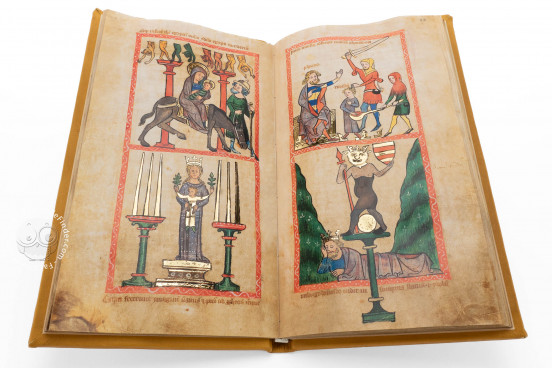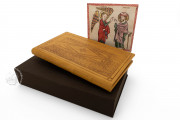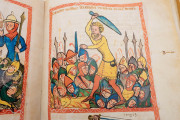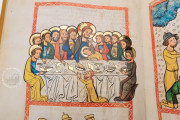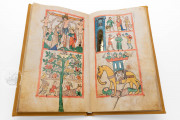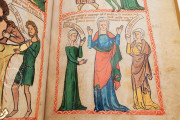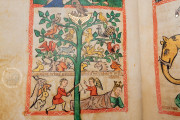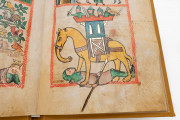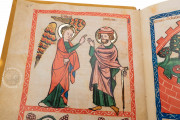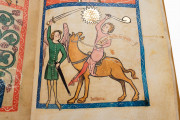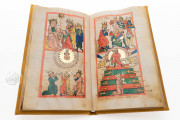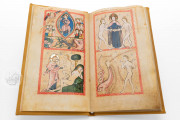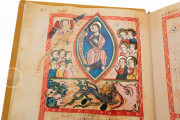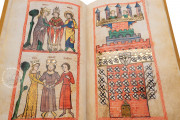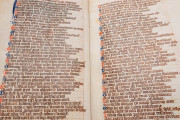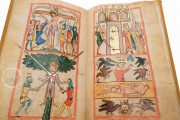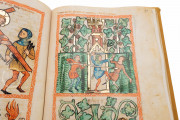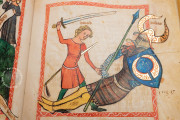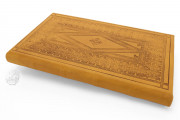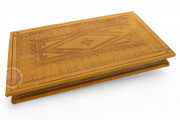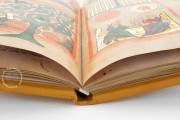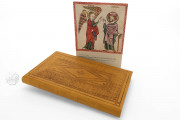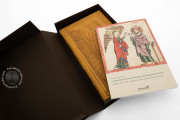The Darmstadt Mirror of Human Salvation is a Christian picture book presenting the history of humanity from the fall of Lucifer, understood to be the devil, to the Last Judgment at the Second Coming of Christ. Made around 1360 in northwestern Germany, perhaps in Cologne, its sixty-eight full-page miniatures are grouped in pairs on facing pages. This arrangement facilitates their contemplation by the reader/viewer. Each pair of miniatures presents four related scenes. The forceful compositions, set against unpainted parchment, are enhanced by inscriptions identifying the figures and the scenes.
The text, which occupies facing pages alternating with the openings bearing images, seeks to explain the relationships among the four preceding pictured events. Most of those relationships are typological (i.e., relating to a form of Christian scriptural interpretation that identifies the meaning of events described in the Old Testament as prefigurations of events in Christian history).
Clarity of Expression
Each set of four images follows an established pattern, most commonly with a New Testament scene at the upper left and three Old Testament types arranged below and on the facing page. For example, the Temptations of Christ appears with three episodes understood to presage Christ's triumph over the temptations: the prophet Daniel defeating the Persian idol Bel and a dragon (below) and—on the facing page—the young David beheading the Philistine warrior Goliath and wrestling a bear and a lion (fols. 26v-27r).
The illuminators, of which there were at least two, presented the stories in compositions that focus on the protagonists and essential actions. Often, the compositions underline the parallels between pictured events. For example, the outstretched arm of Judas in the scene of the Betrayal of Christ is mirrored by the arm of Joab reaching out to kiss Amasa in the scene below (fol. 32v).
Obscure Subjects from the Hebrew Bible
The episode involving Amasa and Joab owes its place in the minds of medieval Christians mainly to the understanding that Joab's kiss and his murder of Amasa prefigured the kiss of Judas that led to the arrest of Christ. The captain of King David's mercenary forces, Benaiah, owes his fame to defeating a lion in a pit of snow, understood to presage Christ's Resurrection (as pictured on fol. 54v).
An Unusual Format
The Mirror of Human Salvation (Speculum humane salvationis) was immensely popular, and most copies, both in manuscript and eventually in print, share a format that includes images and explanatory texts on the same page. The Darmstadt manuscript departs from that convention, resulting in an arrangement that enhances the visual relationships among the depicted episodes.
Couplets Made Clear
A single scribe wrote the manuscript's text in Gothic Textualis, the most formal script of the period. The poetic text is presented in long lines (a single column) on the manuscript's tall, thin pages. Each verse occupies a line, and single-color capitals alternating between red and blue articulate the pattern of rhymed couplets.
Bequeathed to a Community of Nuns
Although we do not know for whom the Darmstadt manuscript was created, it found its way as a gift from one Thidemann, called Cleppinck, to the Franciscan convent of Saint Clara at Clarenberg near Dortmund before the end of the fourteenth century. Much later, in the sixteenth century, it received its current binding, and Johann Wilhelm Carl Adolph von Hüpsch (1730-1805) owned it in the early nineteenth century.
We have 1 facsimile edition of the manuscript "Darmstadt Mirror of Human Salvation": Speculum Humanae Salvationis facsimile edition, published by Imago, 2019
Request Info / Price
